Results
-
 £149.99
£149.99Moretus - Bart Picqueur
Jan Moretus (1543-1610) was a book printer and publisher in his native city of Antwerp. He worked as assistant to his father-in-law, the renowned master printer and publisher Christoffel Plantijn. After Plantijn's death in 1589 Moretus took over the business.The composition Moretus consists of four parts that draw on the remarkable personality of Jan Moretus aswell as the printing business. In both the titles of the movements and the thematic structure we can see a certain symmetry: a playful allusion to the process of printing.Part 1, A Celebrated Gentleman, describes the illustrious figure of Moretus in a festive chorale. In the second part, ExpressiveImpressions, the printing press itself is brought to life in repeated motifs - despite the industrial, mechanical nature of the process, the product always has an artistic and cultural dimension. In the third part, Impressive Expression, the wind band is invited (or challenged), to intone the slow theme with a poignant expressiveness. Part 4, A Gentle Celebration, is a celebratory finale with a fresh theme.
Estimated dispatch 7-14 working days
-
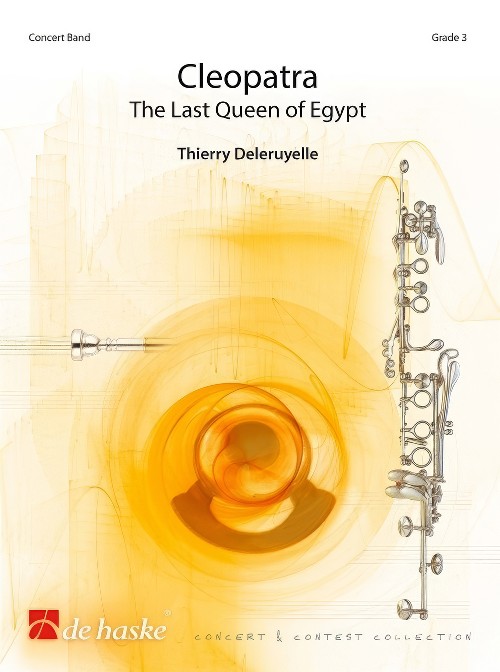 £134.99
£134.99Cleopatra (Concert Band - Score and Parts) - Deleruyelle, Thierry
The Last Queen of Egypt. Queen Cleopatra ruled Egypt for over 20 years. She is one of antiquity's best-known women, in particular because of her relationships with Julius Caesar and, above all, Mark-Anthony, but also because the cause of her death remains a mystery. The work is split into three parts and performed without breaks. The first section begins with a bright introduction representing Mark-Anthony. Dynamic in nature and reminiscent of military music, this characterises the Roman general. But soon after, another theme emerges, softer and more melodic, symbolising Cleopatra's femininity. The two characters then combine on a faster tempo. The middle section of the work depicts the love that Mark-Anthony and Cleopatra feel for each other. This passionate relationship lasted ten years and produced three children. This is expressed by a warm and intense theme, just like the beauty of the Egyptian queen. The third and last section opens in a determined and military mood. Mark-Anthony and Cleopatra were often apart, the Roman general was often away on a campaign. They met up in Alexandria to celebrate their triumph. But, as the targets of the jealousy and ambition of Octavius, Julius Caesar's son, the lovers are trapped and await the inevitable conquest of Egypt by the Romans. When Mark-Anthony heard the false news that Cleopatra had committed suicide, he ended his own life. The Queen of Egypt, for her part, was imprisoned shortly afterwards. The two lovers remain one of History's most famous couples. This piece was commissioned by the Wind Orchestra of the town of Antony, near Paris, directed by Philippe Rossignol, to mark its 90th anniversary. Duration: 10.00
Estimated dispatch 7-14 working days
-
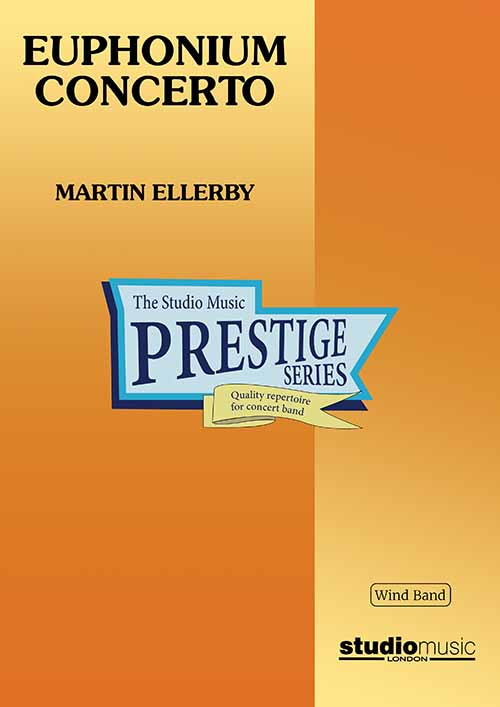 £164.95
£164.95Euphonium Concerto (Concert Band - Score and Parts) - Ellerby, Martin
This Euphonium Concerto was written between late 1994 and early 1995 in response to a commission from Steven Mead to whom the work is dedicated. It is cast in four movements and lasts a little over 22 mins:I. Fantasy: After the briefest of introductions, the solo euphonium enters with the key melodic phrase of the movement in a fast 'Tempo I'. This idea is developed up to the point where a slower 'Tempo II' breaks the argument - here the mood is reflective but it is only to be a brief interruption as 'Tempo I' returns very quickly. The opening material is then subjected to further transformation with 'Tempo II' making occasional returns en route, the distances between the contrasting tempi becoming ever closer, and the movement closes in a rather soft though definite manner.II. Capriccio: This relatively short presto movement forms a bridge between the first movement and the work's slow movement. The majority of the band parts are bright and muted with the percussion players enhancing the texture with contributions from xylophone, glockenspiel and vibraphone. Again the initial solo euphonium phrase provides the basis for almost all the movement's material. This is extremely virtuosic for the soloist and band alike and makes great play of the rhythmic possibilities of combining simple and compound music either in close proximity or together.III. Rhapsody (for Luis): A Lento movement, sitting between two different but essentially rapid ones, this provides the work's emotional core exploiting the soloist's cantabile qualities in an almost seamless fashion. Again, as will all the work's movements, the initial idea paves the way for subsequent development, eventually culminating in a passionate climax; thereafter it winds down with an affectionate backward glance towards the close of the the slow movement of the Euphonium Concerto of Joseph Horovitz, whose mark had been made indelibly on the euphonium repertoire. This movement is dedicated to Luis Maldonado who set the full score of the brass version before his untimely death.IV. Diversions: The work's variation finale is cast in 3/4 throughout though the barline is often a guideline and was seen by the composer as a challenge of metrical restraint! There is an obvious jazz feel to this movement (both rhythmically and harmonically) with a swaggering ritornello theme first announced by the solo euphonium. Thereafter follows a series of interludes and 'adjusted' returns of the main theme. A lyrical idea is allowed to enter but the underlying momentum is ever present. The band also contributes to the interludes and eventually the tempo increases towards a 'wild' and absolute conclusion.Duration: 22.30Recorded on QPRM143D Dreamscapes, Royal Northern College of Music Wind Orchestra
Estimated dispatch 7-14 working days
-
 £32.95
£32.95Euphonium Concerto (Concert Band - Score only) - Ellerby, Martin
This Euphonium Concerto was written between late 1994 and early 1995 in response to a commission from Steven Mead to whom the work is dedicated. It is cast in four movements and lasts a little over 22 mins:I. Fantasy: After the briefest of introductions, the solo euphonium enters with the key melodic phrase of the movement in a fast 'Tempo I'. This idea is developed up to the point where a slower 'Tempo II' breaks the argument - here the mood is reflective but it is only to be a brief interruption as 'Tempo I' returns very quickly. The opening material is then subjected to further transformation with 'Tempo II' making occasional returns en route, the distances between the contrasting tempi becoming ever closer, and the movement closes in a rather soft though definite manner.II. Capriccio: This relatively short presto movement forms a bridge between the first movement and the work's slow movement. The majority of the band parts are bright and muted with the percussion players enhancing the texture with contributions from xylophone, glockenspiel and vibraphone. Again the initial solo euphonium phrase provides the basis for almost all the movement's material. This is extremely virtuosic for the soloist and band alike and makes great play of the rhythmic possibilities of combining simple and compound music either in close proximity or together.III. Rhapsody (for Luis): A Lento movement, sitting between two different but essentially rapid ones, this provides the work's emotional core exploiting the soloist's cantabile qualities in an almost seamless fashion. Again, as will all the work's movements, the initial idea paves the way for subsequent development, eventually culminating in a passionate climax; thereafter it winds down with an affectionate backward glance towards the close of the the slow movement of the Euphonium Concerto of Joseph Horovitz, whose mark had been made indelibly on the euphonium repertoire. This movement is dedicated to Luis Maldonado who set the full score of the brass version before his untimely death.IV. Diversions: The work's variation finale is cast in 3/4 throughout though the barline is often a guideline and was seen by the composer as a challenge of metrical restraint! There is an obvious jazz feel to this movement (both rhythmically and harmonically) with a swaggering ritornello theme first announced by the solo euphonium. Thereafter follows a series of interludes and 'adjusted' returns of the main theme. A lyrical idea is allowed to enter but the underlying momentum is ever present. The band also contributes to the interludes and eventually the tempo increases towards a 'wild' and absolute conclusion.Duration: 22.30Recorded on QPRM143D Dreamscapes, Royal Northern College of Music Wind Orchestra
Estimated dispatch 7-14 working days
-
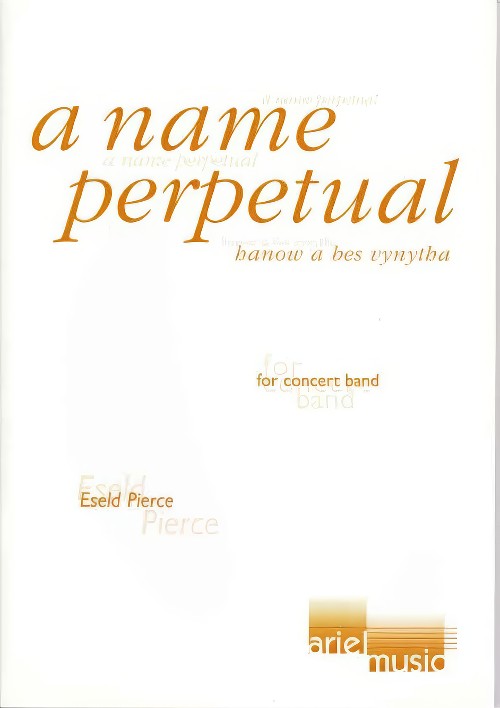 £115.00
£115.00NAME PERPETUAL, A (Concert Band) - Pierce, Eseld
Under the leadership of Michael An Gof and Thomas Flamanck, a Cornish host, sometimes estimated to number as many as 15,000, marched to London in protest against excessive taxation. Arriving at Blackheath, they were attacked by the King's army and defeated, and the two rebel leaders were hung, drawn and quartered. On his way to his death, An Gof stated that he would have "a name perpetual and a fame permanent and immortal". A Name Perpetual tells the story of the Rebellion in four connected scenes. The music includes strong elements of the Celtic music tradition, being structured around an old Cornish folk tune. The first scene introduces fragments of the folk theme and reflects the anguish of the Cornish people. The second scene opens with the folk theme on solo piccolo and, as different instruments enter one by one, the march is depicted with its accumulation of forces en route. The march halts suddenly as the Cornishmen discover the unexpected arrival of the English army and the subsequent music portrays the Blackheath Skirmish. In this scene the orchestra is divided into four parts, each working independently to create a sense of chaos, with the stronger elements of the brass and bass instruments representing the English, while the woodwind and saxophones represent the Cornish, struggling to sustain the folk tune throughout the battle. Eventually all the parts come together and the final section is a lament for the lost Cornishmen, fading away to leave only a haunting off-stage trumpet solo.
Estimated dispatch 7-14 working days
-
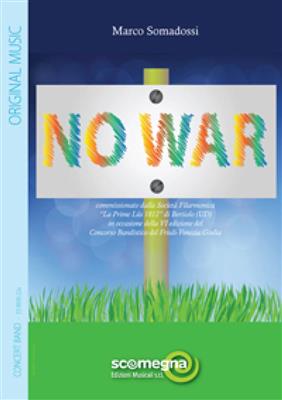 £105.80
£105.80No War - Marco Somadossi
The theme of this composition is immediately evident from the title, which almost requires no further explanation. It will never be possible to represent or reproduce the full implications of a tragedy such as war, all too often forgotten, concealed, exploited or written off as being an evil that is "necessary" for the development of civilisation. War changes the course of human history: man kills man, fathers bury their sons, children take up arms, and mankind is devastated by evil, choosing death over life. The atrocities, repeatedly perpetrated and evident to all observers, are an offence to human dignity. Yet they are tolerated and, at times, even re-interpreted as inevitable remedies for "obstacles" to the global economy, in order- it would seem- to build "a better world". And all this goes on despite the fact that the terrible scars left by past wars are still evident and should serve as a warning to ensure that such tragedies do not return to devastate our world. "No War" is thus a heart-felt protest against any form of culture that justifies war as a means of gaining wealth and power, satisfying the economic needs of the richest countries at the expense of the poorest nations. In so doing the one truly fundamental value is annihilated, that of human life.
Estimated dispatch 7-14 working days
-
 £84.99
£84.99One Life - Thiemo Kraas
Man as an individual and the significance of family and friends - this is the theme that the young talented composer Thiemo Kraas focuses on in One Life. The result is a touching work that describes life from the moment of conception to the final sadness of death. In the work, as in life, melancholic and cheerful sounds alternate which result in a truly masterful composition.
Estimated dispatch 7-14 working days
-
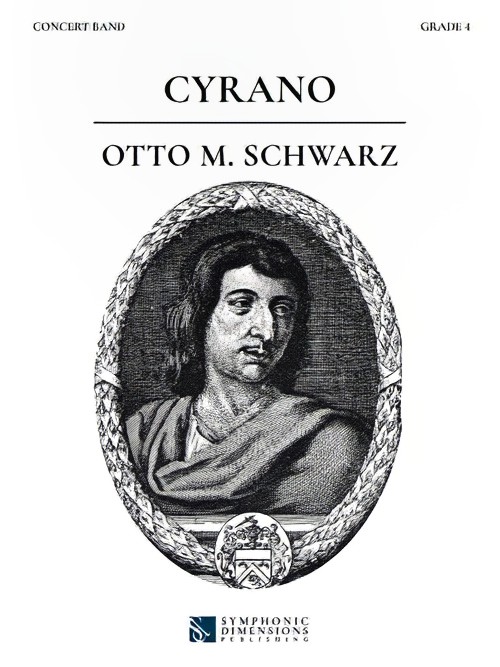 £139.99
£139.99Cyrano (Concert Band - Score and Parts) - Schwarz, Otto M.
What are the true qualities of a person? Outward beauty or inner values? Or perhaps a balance of the two? This question has probably been posed by everyone at some time or another, and the answer is as challenging as it is subjective. This is also the theme of this work. The poet and soldier Cyrano de Bergerac is known for his big nose and his great intellect. The 17th century novelist harbours feelings for the beautiful Roxane but is sure that this love will never be reciprocated. Roxane herself falls in love with the cadet Christian de Neuvillette, who is certainly handsome but could be described as stupid. Cyrano de Bergerac writes love poems on behalf of Christian to win Roxane's heart. And then there is the Count Guiche, who is married but also wants to make her his mistress. Christian and Roxane eventually marry and the furious Count Guiche sends Christian and Cyrano, who serve together in the Captains of Gascony regiment, to the front and, some months later, on a suicide mission. Shortly before the battle, Roxane confesses to her husband that she no longer loves him so much for his beauty as for his inner values. Christian is dismayed and begs Cyrano to tell Roxane the truth, but he can't bring himself to do so. Christian de Neuvillette dies in battle and Cyrano de Bergerac remains silent about the true provenance of the letters. Only much later does the truth come to light: scarred by the war, Cyrano visits Roxane in the convent where she has been living since Christian's death and confesses his love for her. He ultimately dies in Roxane's arms.Duration: 8.30
Estimated dispatch 7-14 working days
-
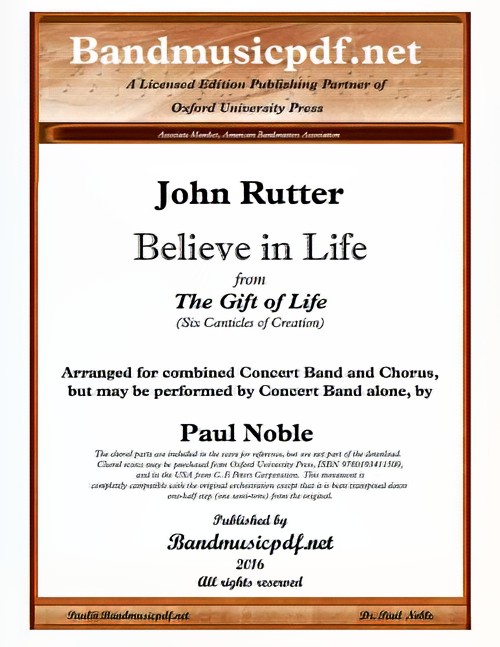 £75.00
£75.00Believe in life (from The Gift of Life) (Concert Band with Optional Choir - Score and Parts) - Rutter, John - Noble, Paul
The Gift of Life was written early in 2015 as a commission to honour a retiring Minister of Music at a church in Dallas, Texas. In planning this piece, John Rutter has stated: In 1985 I had written a Requiem - which, like any Requiem, inevitably reflects on death - why not write the opposite, a work celebrating life? Unlike a Requiem, where a set form of words is laid down in Catholic liturgy, no framework exists for a celebration of life, and I had to choose (and in three cases, write) texts which were appropriate to a theme rarely expressed in music since Haydn's wondrous oratorio The Creation in 1798. The six movements reflect different facets of the miracles of creation and of life. This arrangement is written for combined Concert Band and Chorus, but may be performed by Concert Band alone.
Estimated dispatch 7-14 working days
-
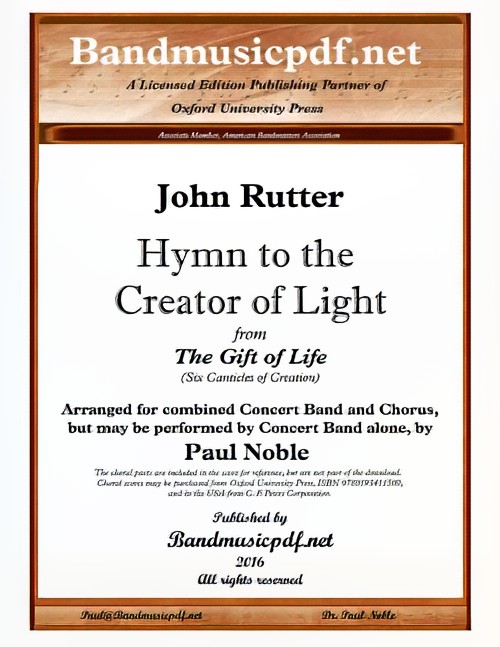 £95.00
£95.00Hymn to the Creator of Light (from The Gift of Life) (Concert Band with Optional Choir - Score and Parts) - Rutter, John - Noble, Paul
The Gift of Life was written early in 2015 as a commission to honour a retiring Minister of Music at a church in Dallas, Texas. In planning this piece, John Rutter has stated: In 1985 I had written a Requiem - which, like any Requiem, inevitably reflects on death - why not write the opposite, a work celebrating life? Unlike a Requiem, where a set form of words is laid down in Catholic liturgy, no framework exists for a celebration of life, and I had to choose (and in three cases, write) texts which were appropriate to a theme rarely expressed in music since Haydn's wondrous oratorio The Creation in 1798. The six movements reflect different facets of the miracles of creation and of life. This arrangement is written for combined Concert Band and Chorus, but may be performed by Concert Band alone.
Estimated dispatch 7-14 working days
